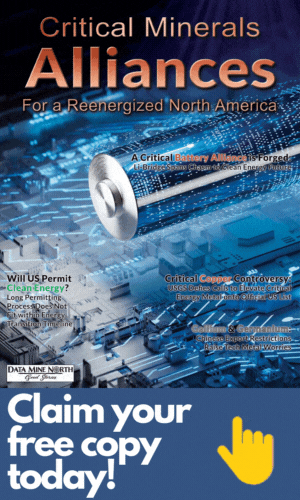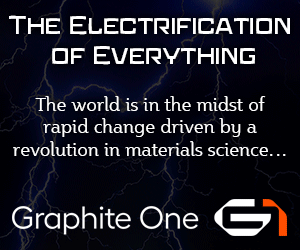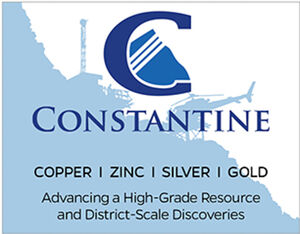Solving solid-state batteries
Defeating dendrites, reducing cost, streamlining production Critical Minerals Alliances 2023 - September 12, 2023
Last updated 9/13/2023 at 4:45pm

Adobe Stock
Solid-state battery technology holds the promise of longer-range and faster-charging electric vehicle batteries that have essentially zero chance of catching fire.
While most leaders in the clean energy sector strongly indicate the concept of solid-state batteries is better, a few hurdles have long held this superior rechargeable battery in the realm of pacemakers and smartwatches, and out of electric vehicles where they are desperately needed.
Solid-state technology replaces the liquid electrolyte in lithium batteries with a solid ceramic or polymer material. This increases energy density, stability, and heat resistance. For EV drivers, this means longer range, faster charging, and essentially zero chance the battery will catch fire.
Since solid-state batteries can achieve a larger capacity and higher output in a smaller form than lithium-ion batteries, they are also making their way into aerospace and naval engineering, which have massive fuel demands that haven't been overlooked in overall clean energy plans for the transportation industry.
A transition to solid-state would also likely increase battery costs and threatens to put companies back at square one, reinventing the EV battery manufacturing processes in order to scale them back up.
Superior design in its infancy
The chemistries of solid-state batteries are generally the same as liquid electrolyte cells – a positive electrode made with similar compounds to lithium-ion batteries but with a solid electrolyte and an anode made of pure lithium to handle much higher energy loads.
While liquid electrolytes have structural restrictions to prevent leakage, solid-state batteries possess a high degree of freedom in shape, adding more power in a lightweight, configurable package.
Safety is also a buzzword in engineering solid-state batteries, which by nature have excellent thermal stability, even if punctured. Due to this reduced flammability, these batteries don't require the same cooling systems to prevent overheating, subtracting further weight from an already compact system.
This removes the key fire risk associated with liquid electrolytes from short-circuiting or physical damage to the membranes separating electrodes which then creates the cascade effect of "thermal runaway." While solid-state batteries are not immune to shorting out, they are much less likely to catch fire because of it.
It's important to note that statistics from the National Transportation Safety Board have shown that EVs catch fire less often than internal combustion engines, and vehicles most prone to fire are hybrids simply because they contain two flammable liquids – gasoline and electrolytes – not because rechargeable batteries are inherently more dangerous.
Solid-state in action
Today's solid-state prototypes have significantly reduced charging times, the latest by Toyota offering a lightning-fast rate of only ten minutes to reach a 745-mile range (and a promised 932 miles in the second generation).
This is a first for EVs-comparable to filling up at the pump. By contrast, Tesla's Supercharger network, the largest of its kind, offers about 200 miles of range on a 15-minute charge. Toyota plans to mass-produce these batteries for industry use by 2027.
With the rush to get solid-state batteries into vehicles for road testing and purchase sooner, automakers can either reduce the price of the battery or the car around it. Affordability in the interim may have to come from engineering focused on facilitating battery mass production, reducing general vehicle fabrication costs, or only putting superior solid-state batteries in high-end car models.
Innovative technologies like giga-casting (aluminum die-casting of a few larger, more simplified parts) and vehicle redesigns focused on production efficiency are all being attempted to bring the cost of solid-state batteries down closer to competing with lithium-ion batteries.
Fatal flaw, surprising solution
Solid-state's most persistent and baffling disadvantage has been that (until now) these ideal batteries seemed to randomly and prematurely short out due to a persistent gremlin – dendrites.
Named after the Latin word for branches, dendrites are soft, microscopic lithium tendrils that begin branching from one electrode to the other during the process of charging and discharging, penetrating even ceramic-based electrolyte, eventually bridging the gap and short-circuiting the cell.
Heavy research and funding have gone into understanding the how and why solid-state batteries fail this way, from in-depth investigations at the Faraday Institution at Oxford to research teams from Brown University and MIT, paid for by the U.S. National Science Foundation, the U.S. Department of Defense, and the U.S. Department of Energy.
Research published in the journal Joule, led by Massachusetts Institute of Technology Professor Yet-Ming Chiang, finally demonstrated that it is not a mysterious electrochemical process but mechanical stresses that cause the problem. Due to compression, stress fractures formed in the solid electrolyte, allowing the electrode's lithium to permeate the material.
"Metal penetration through solid electrolyte separators is a key challenge facing high energy-density batteries, and to date much attention has been directed toward the properties of the separator material through which the metal penetrates," said Paul Albertus, an associate professor of chemical and biomolecular engineering at the University of Maryland.
Eventual separation of the hard layers in solid-state batteries still threatens their efficiency and shortens their lifetimes, and "stack pressure" is often applied to battery cells to reinforce them, essentially compressing the material in the direction perpendicular to the battery's plates-like a panini sandwich.
That pressure was discovered to exacerbate dendrite-induced failure, creating directional cracks like ready-made corridors for the lithium to travel between electrodes. Meanwhile, pressure induced along the plane of the plates caused the dendrites to change direction, never grounding against the opposite electrode.
Rather than capitalizing on this breakthrough, the study has been shared.
"I would say this is an understanding of failure modes in solid-state batteries that we believe the industry needs to be aware of and try to use in designing better products," said MIT Professor Yet-Ming Chiang
This is an elegant solution, but with so many solid-state battery companies developing proprietary products with their own challenges, it won't be the only one.
A problem of scale
Researchers have spent years looking for the right combination of materials, with each fabrication settling on a unique range of problems and solutions, none of which have been easy to put into mass production due to the complexity of creating batteries in a lab as opposed to a factory floor.
Most production difficulties surround the delicate forms that the new chemistries take. Manufacturers are used to working with powders and slurries, but pure lithium works best as a thin, free-standing foil.
"It has the consistency of wet tissue paper," said Solid Power CEO Doug Campbell about scaling up the process. "And so you can imagine when you're making literally kilometers of material, it gets very tricky."
Hedging their bets, the technicians at Solid Power favor an anode mostly made of silicon, which has its own issues of retaining shape under stress.
As battery size increases, tiny imperfections can be compounded, threatening structural integrity as they are scaled up. EV-sized cells don't do as well as they should in the cold, and battery life declines too quickly after repeated fast charging; all problems in ramping up mass production.
Lithium-ion battery makers have advanced over the past 30 years, constructing massive factories and better automation that has driven down costs.
"We don't want to reinvent all the machines," said Shirley Meng, a battery scientist at the University of Chicago. "We want to drop in the solid-state and only make small tweaks. That's the most ideal situation."
Getting in on the action
Solid Power, in collaboration with Ford and BMW, has already started pilot production of a battery design that reuses existing processes and equipment in Colorado that will produce about 15,000 batteries per year – small beans next to gigafactory-scale lithium-ion battery production but is still ambitious in its timing.
The goal, according to Campbell, is to start delivering cells to its automotive partners for road testing by the end of the year, then pass the baton to one of its North American gigafactory-owning partners like SK Innovation.
Hyundai has said it plans to mass produce solid-state batteries by 2030 in a partnership with Factorial Energy, a Massachusetts-based developer of solid-state battery technology. The joint development agreement will integrate Factorial's technology into future vehicles and is drop-in compatible for easy integration of existing lithium-ion battery manufacturing infrastructure.
Both the Stellantis Group and Mercedes have also invested in Factorial, targeting competitive solid-state battery production for 2026, intent on integrating the technology into a limited series of vehicles in the next five years.
Honda expects to release a solid-state-powered EV during the second half of this decade and is testing polymer buffer layers to protect against dendrite formation. The automaker has teamed up with GM and Sony for further research and development.
Nissan is working toward mass production of solid-state batteries by 2028 and aims to launch its first EV powered by a battery developed in-house from a pilot plant up and running in Yokohama, Japan, as early as 2024.
Automotive Cells Co – a venture between Mercedes-Benz, Stellantis, and TotalEnergies – is also developing solid-state batteries with Taiwan-based battery maker ProLogium Technology.
Volkswagen, in collaboration with U.S. battery startup QuantumScape (backed by Bill Gates), plans to build new factories rather than try to retool ones already out there in order to fabricate ceramic and lithium-based battery design that requires a proprietary set of manufacturing processes.
The team is currently building a pre-pilot production line in California to deliver batteries to automakers for road testing within the next year. QuantumScape has published that it also has contracts with five additional yet-to-be-disclosed EV makers.
NASA is also very much involved with electrifying advanced air mobility, from air taxis and ride shares to robotic package deliveries and airborne emergency medical services. NASA's Solid-state Architecture Batteries for Enhanced Rechargeability and Safety (SABERS) have substantial government and industry interest. This still-developing sulfur selenium battery tech is stackable, 40% lighter, discharges 15% faster for serious power, works under twice the temperature extremes of liquid-filled counterparts, and is less affected by rapid changes in pressure that occur during takeoff and landing.
In 2022, industrial manufacturer Hitachi Zosen launched a solid-state battery claiming one of the highest capacities in the industry and a wider operating temperature range. Japan Aerospace Exploration Agency announced the solid-state batteries had properly operated in the vacuum of space, powering camera equipment on the International Space Station.
Room for improvement
Battery production costs still need to be reduced by simpler, more streamlined engineering and chemistry. (Solid-state batteries still cost roughly three times more than standard lithium-ion.)
Challenges to widespread adoption and scalability include durability as size increases, maintaining lower interface resistance, and extension of battery lifetimes (polymer electrolytes are more flexible and headed in this direction).
For any battery to perform well, electrodes and electrolytes must maintain complete surface area connectivity. Compared to liquid electrolytes, layered designs lose efficiency too quickly under normal wear and tear and need resilience to counteract warping, pressure, and cracking.

Toyota Motor Company
Toyota plans to first install solid-state batteries in hybrid vehicles that are slated to be ready for sale as early as 2027.
When electrolytes are changed from liquid to solid, manufacturing processes that differ from lithium-ion batteries are unavoidable. For example, solid-state batteries based on sulfides require facilities with strict moisture control. The key will be in creating high-efficiency new processing facilities or adaptive designs for facilities already in existence.
Additionally, due to compositional similarities, the process of recycling solid-state batteries should adapt as much as possible to the Li-ion battery industry's preexisting recycling infrastructure.
Solid-state batteries have had the support needed to fast-track the creation of a robust market, and the industry has quickly made exceptional progress in research and development. This technology is the key to getting the world to net zero faster, not only through electrified vehicles on the road but across the seas, skies, and even outer space.





















Reader Comments(0)